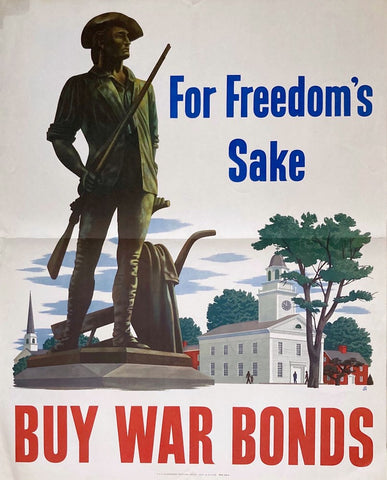Minute Man Imagery in WWII War Bond Posters
After the United States officially declared war on Japan and Germany in December 1941, a large-scale and expensive defense program was launched– one that needed the public’s help to be fully funded. The government received funding directly from United States citizens in the form of War Saving Bonds and Saving Stamps, which were paid back later with interest. It was an opportunity for all Americans- men and women, senior citizens, and even children- to participate in and fund the war effort.
The Treasury worked hard to promote War Bonds in a way that would encourage citizens to feel as though they were personally playing a role in the nation’s defense. The more Americans who felt involved in the defense effort, the easier the transition to a full wartime economy would be. On the eve of the first bond sales, President Roosevelt spoke to the nation on the radio about the “national character of this defense savings campaign.... The determination of all the people to save and sacrifice in defense of democracy.” He concluded by noting that the program was “an opportunity to share in the defense of all the things we cherish.”
To promote the sale of War Bonds, persuasive posters illustrating our country's past patriotic and historical events were painted by some of the best artists of the day. Almost 200,000 different images were produced on loan posters, yet the most used and recognized image in the entire project was the likeness of Daniel Chester French's statue "The Minute Man." It became a rallying symbol for the sale of War Bonds, as well as the official logo for the program.
"For Defense. Buy United States Savings Bonds and Stamps." Vintage WWII Poster, 1941
The Minute Man statue was unveiled on the centennial of the Battle of Lexington and Concord, which was fought on April 19, 1775 in Concord, Massachusetts. Daniel Chester French, a Concord resident himself, modeled his sculpture soldier on Captain Isaac Davis, the first officer to die in the Revolutionary War. Although no paintings of Davis survived, French looked at pictures of his relatives and examined clothing of the period that had been preserved by townspeople to recreate the famous figure’s likeness.
An important detail of French’s sculpture is the plow, from which the Minute Man turns with gun in hand. This recalls the Roman legendary figure of Cincinnatus, who left his farm to lead the armies of Rome against their enemies, and then surrendered his power to return to his plowing. Cincinnatus was regarded as a paragon of republican virtue in the early United States, an example of the preservation of democratic governance through self-sacrifice—and thus a fitting symbol for the themes of the Defense Bond drives.
"For Freedom's Sake. Buy War Bonds" Vintage WWII Poster, 1943
The Treasury adopted the Minute Man design over other proposed logos because it was well known, distinctly American, and embodied the ideal of average citizens playing a part in the defense of the nation. The Minute Men of the 18th century were so named for their ability to “be ready at a minute’s warning with a fortnight’s provision, and ammunition and arms.” They were remembered as a courageous band of farmers who responded to a spontaneous call to arms to turn back the British Army at Lexington and Concord. The mythic sentiment of a minute man was useful to the bond drive as a representative of a common citizen doing his part to aid in the defense of the country, whenever needed.
The Minute Man Statue silhouette appeared on Defense Savings Stamps, in advertisements, and on posters. Even the official publication of the Defense Savings Staff was titled “The Minute Man.” Citizens who purchased Defense Bonds and employers who participated in Defense Bond payroll programs proudly displayed the Minute Man signs and flags in their homes, shops, factories, and stores. The terms “Minute Man” and “Minute Woman”were also used for the WWII volunteers who visited neighbors or solicited co-workers to encourage bond sales and specific loan drives.
By the end of the war, 85 million Americans (out of a population of 131 million) had purchased $185.7 billion dollars of bonds – over $2,000 per person, at a time when the average income was $2,000 per year. The patriotism and personal sacrifice of the average citizen played a significant part in the Allied war effort. As victory appeared near, Roosevelt reiterated that it “was largely due to American teamwork... and every one—every man or woman or child—who bought a war bond helped—and helped mightily!”




 "She's Ready, Too. Buy War Bonds" Vintage WWII Bonds Poster, 1942
"She's Ready, Too. Buy War Bonds" Vintage WWII Bonds Poster, 1942



